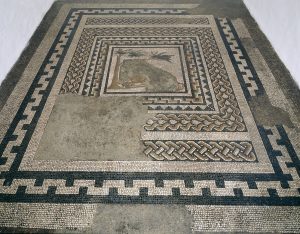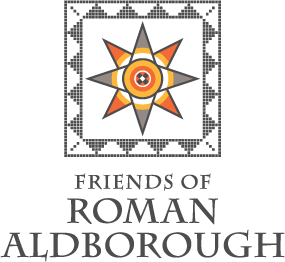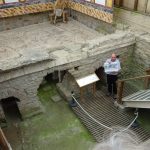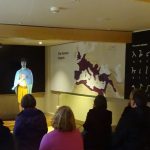Paving Roman Aldborough: Mosaics and their Makers
Will Wootton, King’s College
Saturday 5th September 2015
Having conducted extensive research on mosaics throughout the world Will Wootton, lecturer in Roman Art at King’s College, London kindly agreed to journey north and share some of his extensive knowledge with the Friends of Roman Aldborough. Will is a leading authority on mosaic production, techniques and modern conservation and as such has recently been involved in a project to help protect Libya’s unique archaeological heritage during the country’s high profile civil war. He travelled up to North Yorkshire to explain how and why the Aldborough mosaics were produced and to compare them with others in Roman Britain and the ancient Mediterranean.
Through his work with ASPROM (The Association for the Study and Preservation of Roman Mosaics) he is well acquainted with Stephen Cosh and David Neal’s “The Roman Mosaics of Britain” published in four volumes. This massive work is the first complete corpus of the Roman mosaics of Britain and lists and describes every known mosaic. All significant mosaics are illustrated, many with the acclaimed tessera-by-tessera colour paintings by the authors.
Will began by describing some of the most significant mosaics found in Aldborough, the most well known are now residing in Aldborough Museum and Leeds Museum. Others remain buried in the basements of houses in the village. The reference numbers are those used by Cosh and Neal.
Borough Hill 123.1-3
Francis Drake noted that mosaics had been found in Borough Hill not long before he published “Eboracum” in 1736. The only knowledge we now have of these are through drawings, some of which were published in 1852 by Henry Eckroyd Smith in his “Reliquiae Isurianae”. This mosaic was extremely intricate and does not reflect the others.
Close to Aldborough Manor 123.17
This was found between 1779 and 1848 and was originally only visible through a set of trap doors. Again the drawing was published in 1852 by Eckroyd Smith when colour was added to the drawings. Some would say this was, at times, “fanciful” and not always accurate.
Globe Alehouse
This cost 3d to view in a subterranean room. A sign on the building read:
Here is the Ancient Manor House
And in it you may see
The Roman works
A great curiosity
Admission Threepence Each
An engraving was made in 1804. The mosaic was covered up in 1906 but uncovered in the 1980’s. A modern mosaic in the entrance of Aldborough Manor may have been inspired by this original.
Lion Mosaic 123.13

Photo English Heritage
This dates from 2nd century AD and was discovered in 1832 when the landlord of the Aldburgh Arms decided to bury a calf at the end of his garden. Again recorded by Smith in 1852, it was also reported in the Illustrated London News 20th January 1849 citing souvenir hunters as being responsible for damage to the central panel. It now shows signs of considerable wear with some patching and regrouting.
Romulus and Remus 123.19

Photo Leeds City Museum
This was discovered in the 1840’s near the East gate of the town but was not published by Smith in 1852. In 1862 it was reported by Charles Moore Jessop to be in the possession of a bricklayer in Boroughbridge with “fanciful additions.” A local mason called Lonsdale had relayed it as the floor to a summer house in the garden of his Boroughbridge cottage. It was purchased by Leeds Literary and Philosophical Society and found its way to Leeds Museum.
There has been much discussion about its authenticity based on the quality, workmanship and iconography. The outer border is crude, as is the depiction of the she wolf. Some believe that it is the subject of heavy Victorian restoration. Others believe that its naivety is indicative of provincial art from that period and compare it closely to the Rudston Venus.
Muses 123.15
Discovered in 1846 behind the Black Swan Inn (Aldburgh Arms) and re- excavated in 1976 – 80. It original belonged to a bipartite apsidal room. A portion now resides in the museum showing Thalia, the Muse of Comedy. It is a very rare example of a mosaic with a Greek inscription. It is the only example in Britain and one of very few in the whole of the north- west provinces. There are two other surviving examples in Cologne. It hints at the literary and cultural sophistication of the owner.
Mosaics comprise surfaces composed of individual pieces used to create a decorative effect set in mortar bedding. Tied to architecture, they are functional but not portable. Some may contain hidden meanings which have become lost with the passage of time. Their design and quality tell us something about the people who originally commissioned them.
Mosaic experts have looked for similarities in designs. In the 1960’s David Smith believed the same people might have been responsible for the construction of those with common features. He thought that the Aldborough mosaics belonged to the Northern Group together with those from Dalton Parlours and Malton. The Petuarian School from around Brough on Humber contained those from Horkstow , Winterton and Brantingham.
Aldborough designs contain swastikas like other Yorkshire mosaics at Hovingham and Beadlam. Lincolnshire designs have basic layouts – a square flanked by two rectangles with linear lozenges surrounding scales and chequers.
There was great variability in the central figurative representations but common patterns were used in the borders. Both Aldborough and Michelgate, York mosaics use intersecting linear and octagonal designs.
Clues have been found as to the methods of construction. At Rudston, piles of tesserae were found heaped up against a wall sorted by colour and size. Work was taking place on site. At Aldborough the materials used in the Helakon Muses mosaic – white fine crystalline glass could be found within an 80 km radius.
At Badminton Park all the materials could be found less than 10 – 15 miles from the site. Roof tiles were knapped, lias limestone and pennant sandstone were reused from the building materials. Piles of waste were deposited not far from the building. On other sites, deposits were found under the portico roofs suggesting that preparation of materials was done outside, but close to the rooms where they were to be installed.
Vitruvius and Pliny write about mosaic construction being like layers of a cake starting with the base and working upwards. Will believes that the vast majority of mosaics were made on site using the direct method. Some footprints of bare feet belonging to women and children have been found under some mosaics suggesting that they have been involved in trampling down the lime mortar. Guidelines have also been found incised or painted into the mortar. Using guideline strings the mosaic makers would have skillfully measured out these starting points for their intricate repetitive patterns. This would not have been done if the mosaics had been prepared off site. Small decorative panels, approximately 50 x 50cm would have been made in studios and then set in place later but very few in the ancient world would have been made off site using the indirect method.
It is testament to the skill and dexterity of these early workers that in Woodchester the Woodward Brothers recreated The Great Pavement. It took them 10 years. The original took 330 days.
Will found spending a weekend in Aldborough “utterly fascinating”. “The mosaics here range from run of the mill – middling – to high status with extraordinary images showing strong allegiance to the imperial cult”. He answered all our questions, but finished by saying that major research questions could be based around the Aldborough mosaics.“ How did they fit in to the local economy?” “Who commissioned the Aldborough mosaics?”
These are only two of the questions that might be asked.





